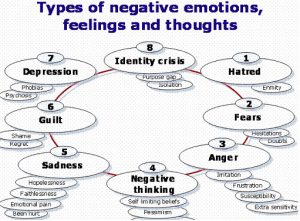By Ray Williams
March 15, 2019

Are we hardwired to think and feel negatively? Is it possible and desirable to be (or try to be) positive and happy all the time? Can we do anything about our negative thoughts and emotions so they don’t create serious problems?
11 Common Myths about Emotions and Why You Should Stop Believing them
- There is an appropriate feeling for every situation. Truth: our emotions react to both external and internal events which change every time
- Painful emotions should be ignored. Truth: if we avoid to repress painful emotions, we don’t learn how to deal with them, and they can cause dysfunctional responses
- Showing emotions is a weakness. Truth: if we first acknowledge our emotions when we are feeling them, an appropriate emotional expression is less problematic
- Negative emotions are bad. Truth. They just are and they are useful. The important thing is how we react to them
- Some emotions are stupid. Truth: all emotions are there for a reason and can be useful for us.
- Emotions may happen to us for no reason. Truth: When emotions arise, they do so as a way of telling us we need to do something about how we are dealing with an internal or external event.
- Emotions are facts. Truth: they are nothing more than mental and physical events that are temporary unless we wish to hold on to them.
- Experiencing emotions is the same as expressing emotions. Truth: Feeling an emotion such as anger is not the same as the behavior of slamming a door, yelling at someone or physically attacking someone which are behaviors we choose.
- Experiencing strong emotions equals loss of control. Truth: each situation is different. Expressing grief or sadness when you lose someone is healthy, whereas cutting someone off in road rage is unhealthy.
- Emotions last forever. Truth: Emotions are short lived unless we want to suffer, or be in a “mood,” or if we suppress or block emotions.
- You can’t help how you feel. Truth: Emotions originate from our thoughts about some situation. It’s not the situation itself that triggers emotions but our interpretation of it. You can learn to interpret things the way you want to, including positively. And thus when you control your thoughts you control your emotions. Control means regulate.

All Emotions Serve a Purpose
The truth is, there is no such thing as a negative emotion, since each emotion has its own role and purpose. In fact, in the book, The Upside of Your Dark Side, authors Todd Kashdan, Ph.D., and Robert Biswas-Diener argue that in order to attain happiness, one has to welcome every emotion (pleasant or unpleasant) and learn how to make the best of them. It is not the emotion that is problematic but rather the way we deal with them that can be. Instead of pushing these emotions away, we should learn to welcome and listen to the important messages these feelings are trying to communicate to us.
Human beings have the ability to experience a wide variety of emotions that span “feel good” to “uncomfortable.” Each emotion along this continuum has its function and provides important information about our environment. For instance, fear warns us about potential danger, anxiety can relate insecurities or unpreparedness, anger can signal that someone or something has transgressed us. It is not the emotion itself that is problematic. Rather, it is the way we deal with this information that can either help or hinder us.
In fact, anger and sadness are an important part of life, and new research shows that experiencing and accepting such emotions are vital to our mental health. Attempting to suppress thoughts can backfire and even diminish our sense of contentment. “Acknowledging the complexity of life may be an especially fruitful path to psychological well-being,” says psychologist Jonathan M. Adler of the Franklin W. Olin College of Engineering.
Negative emotions also most likely aid in our survival. Bad feelings can be vital clues that a health issue, relationship or other important matter needs attention, Adler points out. The survival value of negative thoughts and emotions may help explain why suppressing them is so fruitless. In a 2009 study psychologist David J. Kavanagh of Queensland University of Technology in Australia and his colleagues found those who often fought against intrusive alcohol-related thoughts actually harbored more of them. Similar findings from a 2010 study suggested that pushing back negative emotions could spawn more emotional overeating than simply recognizing that you were, say, upset, agitated or blue.
The capacity to emphasize the negative rather than the positive has probably been an evolutionary phenomenon. From our earliest beginnings, being aware of and avoiding danger has been a critical survival skill.
Your Brain and Negative Thinking and Emotions
According to Rick Hanson, Ph.D., a neuropsychologist, founder of the Wellspring Institute for Neuroscience and Contemplative Wisdom, and New York Times best-selling author, humans are evolutionarily wired with a negativity bias. Our minds naturally focus on the bad and discard the good. It was much more important for our ancestors to avoid threats than to collect rewards: An individual who successfully avoided a threat would wake up the next morning and have another opportunity to collect a reward, but an individual who didn’t avoid the threat would have no such opportunity.
Hanson describes the brain as like “Velcro for negative experiences and Teflon for positive ones.” While some individuals may be inherently more optimistic than others, it’s generally true that in order for positive experiences to “stick” in our brains as well as negative ones do, these positive experiences need to be held in our consciousness for a longer period of time.
“The alarm bell of your brain — the amygdala (you’ve got two of these little almond-shaped regions, one on either side of your head) — uses about two-thirds of its neurons to look for bad news: it’s primed to go negative,” writes Hanson. “Once it sounds the alarm, negative events and experiences get quickly stored in memory — in contrast to positive events and experiences, which usually need to be held in awareness for a dozen or more seconds to transfer from short-term memory buffers to long-term storage.”

How negative thinking changes the brain
The more that an individual’s thought patterns trend negative and slip into rumination—continually turning over a situation in one’s mind and focusing on its negative aspects—the easier it becomes to return automatically to these thought patterns.
That’s not so great for our health. According to a blog post on Psychology Today, ruminating can damage the neural structures that regulate emotions, memory, and feelings. Even when our stress and worry is completely hypothetical and not based on any real or current situation, the amygdala and the thalamus (which helps communicate sensory and motor signals) aren’t able to differentiate this hypothetical stress from the kind that actually needs to be listened to.
Cortisol, a stress hormone, breaks down the hippocampus, the part of the brain that helps form new memories. Most people experience a peak of cortisol in the morning, but it can also spike throughout the day in response to stress. The more cortisol that’s released in response to negative experiences and thoughts, the more difficult it can become, over time, to form new positive memories.
In neuroscience, the expression “neurons that fire together, wire together” describes “experience-dependent neuroplasticity”—essentially, the concept that our brains are shaped by our thoughts and experiences. According to Hanson, the synapses in our brains that fire frequently become more sensitive. Our experiences and thoughts can lead to the growth of new synapses and even change our genes, altering the very structure of our brain. Or, as Hanson writes, “the brain takes its shape from what the mind rests upon.
Negative emotions can be described as any feeling which causes you to be miserable and sad. These emotions make you dislike yourself and others, and take away your confidence. Emotions that can become negative are hate, anger, jealousy and sadness. Anxiety, fear, and guilt can become negative if they are severe.
Brain imaging has revealed that positive and negative emotions are polarized on opposite sides of the prefrontal cortex. The right side governs a physiological loop that produces negative, inhibiting feelings, while the left commands a loop for positive, outward-reaching.
Other research insights about negative emotions
- If you are having negative thoughts or emotions, the very act of pushing them away and adopting the sense they are intrusive, actually makes them more powerful. The vast majority of our thoughts, are at best random and at worst destructive.
- 95% of our thoughts are replaying movies, movies and recollecting past events.
- There are far more words in our everyday language to express negative feelings. A study shows 50% are negative, 30% positive and 20% neutral
- When we have negative emotions to tell us something is wrong, we are more likely to spend more attention on them.
- There is no such thing as a negative emotion, since each emotion has its own role and purpose.
- In order to attain happiness, one has to welcome every emotion pleasant or unpleasant and learn how to make the best of them. It is not the emotion that is problematic but rather the way we deal with them that can be. Instead of pushing these emotions away, we should learn to welcome and listen to the important messages these feelings are trying to tell us.
- Our body reacts to our mental and physical sensations. We then label them as good, bad or neutral. Emotions are never really good or bad, positive or negative. We need every emotion. The difficulty is when holding on to one emotional experience becomes distressing to functioning in our daily lives. People who avoid all the negative and only live in the positive and vice versa do not deal with the full experience of living.
- Too often our minds convince us that we must stay in negative emotion states to justify the feelings we have at present
The concept of negativity bias is not new. Early research has led to theories such as The Prospect Theory, which evaluates the way people make choices when there is a known risk. So negativity bias and the Prospect Theory advances the idea that people are more likely to choose things based on their need to avoid negative experiences, rather than their desire to get positive experiences. This phenomena has been examined by researchers such as Roy F. Baumister, Ellen Tratslavsky, Kathleen Vohs, and Catrin Finkenauer. These psychologists concluded negative experiences or the fear of them has a greater impact on people than positive experiences.
Paul Rozin and Edward Royzman showed in their research that the negative perspective is more contagious than the positive perspective. A study by John Cacioppo and his colleagues showed that our attitudes are more heavily influenced by bad news than good news. Other researchers analyzed language to study negativity bias. For example, there are more negative emotional words (62 percent) than positive words (32 percent) in the English dictionary.
In our brains, there are two different systems for negative and positive stimuli. The amygdala uses approximately two thirds of its neurons to detect negative experiences, and once the brain starts looking for bad news, it is stored into long-term memory quickly. Positive experiences have to be held in our awareness for more than 12 seconds in order for the transfer from short-term to long-term memory. Rick Hanson describes it in this way: “The brain is like Velcro for negative experiences but Teflon for positive ones.”

A recent study by Jason Moser and his colleagues at Michigan State University, and published in The Journal of Abnormal Psychology have found brain markers that distinguish negative thinkers from positive thinkers. Their research suggests that there are in fact positive and negative people in the world. In their experiments they found people who tend to worry showed a paradoxical backfiring effect in their brains when asked to decrease their negative emotions, which Moser said, “suggests they have a really hard time putting a positive spin on difficult situations and actually make their negative emotions worse even when they are asked to think positively.”
Christopher Nass, a professor of communication at Stanford University and co-author of The Man Who Lied To His Laptop: What Machines Teach Us About Human Relationships, argues that we tend to see people who say negative things as being smarter than those who are positive. Thus we are more likely to give greater weight to criticism than praise.
Psychologist Mihaly Csikszentimihalyi contends that unless we are occupied with other thoughts, worrying is the brain’s default position. This is why, he says, “we must constantly strive to escape such ‘psychic entropy’ by learning to control our consciousness and direct our attention to activities which provide ‘flow’ activities which give positive feedback and strengthen our sense of purpose and achievement.” His views echoes those of Martin Seligman and Rick Hanson who both make the point that while negative emotion always has the ability to “trump” positive emotion, we have to learn how to keep negative emotion in check by amplifying positive emotions.
Our limbic (or reptilian brain) creates the physical responses to emotions. All too often then our thinking brain creates meaning of those experiences and responses. Rarely the other way around.
Emotions are momentary bio-psychological experiences that combine the psychological judgment of an experience into a joint body-mind response. Each emotion is like a wave on the water that comes with its own level of intensity and its own effect on the worl
ARE NEGATIVE EMOTIONS NECESSARILY BAD OR TO BE AVOIDED?
Emotions are never really good or bad, positive or negative. We need every emotion. The difficulty is when holding on to one emotional experience becomes distressing to functioning in our daily lives. People who avoid all the negative and only live in the positive (and vice versa) do not deal with the full experience of living and creating an aversive response to the world around us.
As mentioned earlier, emotions are psycho-physical responses. The body is designed for survival and each emotion adjusts the body to react to the environment the best. Fear puts the body into a mild state of shock and pulls resources for safety. Anger releases a lot of blood flow for quick action.
Our body reacts to our mental and physical sensations. We then label them good, bad or neutral. This determines our feelings. Our body and mind then acts on the evaluation of those feelings to create emotions.
Our negative emotions are necessary parts of us, but when we live with them too long they can harm our health.
SO HOW DO I KNOW IF I AM BEING UNHEALTHY WITH MY EMOTIONS?
The more that an individual’s thought patterns trend negative and slip into rumination—continually turning over a situation in one’s mind and focusing on its negative aspects—the easier it becomes to return automatically to these thought patterns.
That’s not so great for our health. According to a blog post on Psychology Today, ruminating can damage the neural structures that regulate emotions, memory, and feelings. Even when our stress and worry is completely hypothetical and not based on any real or current situation, the amygdala and the thalamus (which helps communicate sensory and motor signals) aren’t able to differentiate this hypothetical stress from the kind that actually needs to be listened to.
Ways To Deal With Negative Emotions
Step 1: Reverse the Approach
Most people seeking help with their negative emotions are grappling, trying to stop feeling so miserable and negative. The harder they try, the harder it gets. Now picture this – if you’re walking down a street and see a few stray dogs, what would be the smartest thing to do? Run? A smart person knows that running isn’t the solution. In fact, the faster you run, the more dogs will chase after you. It’s the same for negativity. Stop trying to feel better. Let the pain come. Contrary to what you think, you will not remain depressed for the rest of your life or cry for days. That happens when you resist your pain. For once, let the pain come. Don’t resist it.
Step 2: Face It
Depression, anxiety, fear, and other ‘negative’ emotions are most commonly just a sign of a healthy mind. Of course when a person loses a job they’re going to feel afraid and unsettled. Of course when they lose someone they love they are going to feel lost and in pain. It is a sign that you are feeling. It’s natural! What makes it permanent is our refusal to acknowledge and feel it – must like the refusal to acknowledge and handle the trash in our house, it will soon start to stink and create disease. Which is exactly what it does. When we face our emotions, it is important to stay true to our feelings – not our thoughts. A thought is a programmed response to an unpleasant feeling. So whenever the mind starts going crazy, instead of trying to control the mind, ask yourself one question – ‘what am I really feeling right now?’ And feel that more deeply.
Step 3: Be Honest
This process often works like magic. And those who have seen its effect have a strong tendency to fall into the trap of pretending to feel so that the feeling goes away. If you find yourself thinking ‘Oh I’ve been feeling my emotions for the last 2 days and I still feel miserable’, you aren’t focused on the emotion at all, you’re focused on feeling better, which is exactly the opposite of what you need to do. Sometimes a feeling that is associated with our core identity can remain for months before it goes away for good. Sometimes the pain comes emotionally and sometimes it is physical. In either case, what you are doing is surrendering to your present moment with your full awareness. Do this honestly.

Strategies from Research
New research shows that two types of psychological strategies — cognitive restructuring and diffusion — can help people cope with negative thoughts.
Heading a team of Swedish scientists, Andreas Larsson points out that up to 99 percent of the world’s population may experience negative thoughts. These ideas are the kind of unwanted thoughts that occur regularly, such as worrying about being unloved by others. At worst, these thoughts can even contribute to the formation of mental illnesses. As a result, it makes sense to try to manage these thoughts. In a study published in Behavior Modification, Larsson’s team reported that they found support for using certain methods to curb these types of negative thoughts.
Larsson’s team gathered together 71 subjects for their study and split them evenly into three different groups. Every participant in the study was then instructed to come up with a negative thought about themselves. This thought needed to be believable, uncomfortable to have, extremely negative, and not about their physical bodies. Importantly, the thought also needed to be something the subjects didn’t want to thinking about. The subjects in two of the groups were then given instructions about using cognitive restructuring or diffusion to manage their thoughts. The third group received no instructions on how to manage their thoughts at all.
Cognitive restructuring stems from a form of therapy called cognitive-behavior therapy. The technique is based on the idea that changing how someone thinks about something will change how they feel and behave relating to that thing. Using this technique involves thinking about the negative thought itself and evaluating it to see if the thought is realistic or not.
Diffusion is based on acceptance and commitment therapy. The idea behind this technique is to learn to view thoughts as nothing more than ideas. There is no need to address them as they don’t mean nearly as much as people commonly think that they do. A common thing people using diffusion do is constantly repeating a word until it loses some of its meaning. This way, they may spot some of their beliefs concerning that idea.
Larsson’s team found that people who had been trained to use defusion and cognitive restructuring dealt with negative thoughts far better than those who had received no training. Even so, defusion was the more efficient technique of the two. As such, people looking to deal with negative thoughts might want to use diffusion over cognitive restructuring although both appear to address these types of thoughts well.
Happy People Deal with Negative Emotions Better
Happier people are able to focus on positive things and filter out the negative. Another reason is that happier people could be better at savoring good moments and emotions to help them deal with negative events. But why does this matter? Because this has implications for your perspective on life. Is it better to ignore the negatives, or strengthen your ability to focus on the good while acknowledging the bad?
Researchers Cunningham and Kirkland recorded the amygdala activity of 42 participants as they viewed series of positive, negative, and neutral pictures. Participants also filled out surveys to determine their subjective happiness levels. When compared with less-happy people, the researchers found that happier people had greater amygdala activation in response to positive photographs. But they did not have a decreased response to negative images, as would be predicted by the “rose-colored glasses” view of happiness. According to the paper, this suggests that “happier people are not necessarily naïve or blind to negativity, but rather may respond adaptively to the world, recognizing both good and bad things in life.”
This is interesting because it suggests that being able to sense and respond to negative information may actually be an important component of happiness. The authors’ conclusion from this study: “Happy people are joyful, yet balanced.”
But You Can’t Force Yourself to be Happy
Svend Brinkmann from Aalborg University says forcing ourselves to be happy all the time could leave us emotionally stunted. And what’s more, happiness simply isn’t the appropriate response for all situations in life. It’s news that may make you breathe a sigh of relief – not only is it OK not to feel constantly happy, but it’s right according to Brinkmann, whose book Stand Firm: Resisting the Self-Improvement Craze was a Danish bestseller.
“I believe our thoughts and emotions should mirror the world. When something bad happens, we should be allowed to have negative thoughts and feelings about it because that’s how we understand the world,” he says. Brinkmann believes that by desperately trying to be happy all the time, when something bad does happen, we won’t be able to cope. “Life is wonderful from time to time, but it’s also tragic. People die in our lives, we lose them, if we have only been accustomed to being allowed to have positive thoughts, then these realities can strike us even more intensely when they happen – and they will happen.”
Of course, there are people who seem naturally to have more cheery outlooks on life, and Brinkmann acknowledges that. But he says there’s a danger in happiness becoming a necessity and warns of the perils of companies insisting on employees being perpetually upbeat.
“When you engage with people and you work in teams, then these personality traits become much more important. That’s why we put much more emphasis on them, because we want to exploit humans and their emotional lives,” says Brinkmann. “I think this is a dark side of positivity. Our feelings tend to become commodities and that means we’re very easily alienated from our feelings.”
He also fears society is getting to a point where people don’t even feel they can discuss their worries and problems with their own friends because they think they need to pretend everything is rosy all the time. We’re all subjected to a pressure to be happy, according to Brinkmann – he is anti self-help books that tell us we’re all responsible for our happiness and to blame for our sadness. Because without the bad things in life you’d never appreciate the good, and it’s fine to feel sad, angry, guilty, ashamed and happy too.
Pause for positivity three times a day
Our brains naturally tend toward the negative, so it’s all-too easy to go there. But that doesn’t mean that we have to live in this pessimistic, powerless place. We can choose another approach. An approach that actually empowers and energizes us. In the new book The Science of Positivity: Stop Negative Thought Patterns By Changing Your Brain Chemistry, Loretta Graziano Breuning, suggests this helpful practice: Stop and think about something good three times a day for 6 weeks. Specifically, she writes, “spend one minute each time scanning for the positive aspects of situations that are currently on your mind,” and “define ‘good’ however you want.” She shares these excellent examples of shifting our thinking:
Being positive isn’t about denying reality or glossing over the truth. It’s not about being blind. Again, Breuning suggests looking for good things that are relevant to our present reality. As she also notes, “For best results, do not focus on puppies, rainbows and butterflies.” Focus on the thoughts that empower and inspire you. Focus on the thoughts that help you build meaning, thoughts that build a fulfilling life.
Positive thoughts and emotions can, of course, benefit mental health. Hedonic theories define well-being as the presence of positive emotion, the relative absence of negative emotion and a sense of life satisfaction. Taken to an extreme, however, that definition is not congruent with the messiness of real life. In addition, people’s outlook can become so rosy that they ignore dangers or become complacent [see “Can Positive Thinking Be Negative?” by Scott O. Lilienfeld and Hal Arkowitz; Scientific American Mind, May/June 2011].
Eudaemonic approaches, on the other hand, emphasize a sense of meaning, personal growth and understanding of the self—goals that require confronting life’s adversities. Unpleasant feelings are just as crucial as the enjoyable ones in helping you make sense of life’s ups and downs. “Remember, one of the primary reasons we have emotions in the first place is to help us evaluate our experiences,” Adler says.
Adler and Hal E. Hershfield, a professor of marketing at New York University, investigated the link between mixed emotional experience and psychological welfare in a group of people undergoing 12 sessions of psychotherapy. Before each session, participants completed a questionnaire that assessed their psychological well-being. They also wrote narratives describing their life events and their time in therapy, which were coded for emotional content. As Adler and Hershfield reported in 2012, feeling cheerful and dejected at the same time—for example, “I feel sad at times because of everything I’ve been through, but I’m also happy and hopeful because I’m working through my issues”—preceded improvements in well-being over the next week or two for subjects, even if the mixed feelings were unpleasant at the time.
“Taking the good and the bad together may detoxify the bad experiences, allowing you to make meaning out of them in a way that supports psychological well-being,” the researchers found.
Negative emotions also most likely aid in our survival. Bad feelings can be vital clues that a health issue, relationship or other important matter needs attention, Adler points out. The survival value of negative thoughts and emotions may help explain why suppressing them is so fruitless. In a 2009 study psychologist David J. Kavanagh of Queensland University of Technology in Australia and his colleagues asked people in treatment for alcohol abuse and addiction to complete a questionnaire that assessed their drinking-related urges and cravings, as well as any attempts to suppress thoughts related to booze over the previous 24 hours. They found that those who often fought against intrusive alcohol-related thoughts actually harbored more of them. Similar findings from a 2010 study suggested that pushing back negative emotions could spawn more emotional overeating than simply recognizing that you were, say, upset, agitated or blue.
Negative Thinking
Even if you successfully avoid contemplating a topic, your subconscious may still dwell on it. In a 2011 study psychologist Richard A. Bryant and his colleagues at the University of New South Wales in Sydney told some participants, but not others, to suppress an unwanted thought prior to sleep. Those who tried to muffle the thought reported dreaming about it more, a phenomenon called dream rebound.
Suppressing thoughts and feelings can even be harmful. In a 2012 study psychotherapist Eric L. Garland of Florida State University and his associates measured a stress response based on heart rate in 58 adults in treatment for alcohol dependence while exposing them to alcohol-related cues. Subjects also completed a measure of their tendency to suppress thoughts. The researchers found that those who restrained their thinking more often had stronger stress responses to the cues than did those who suppressed their thoughts less frequently.
Based on a technical definition, negative thinking is a mental attitude of anticipating the worst possible outcomes on situations, events, and circumstances. It is the ability of the mind to produce thoughts that are not deemed favorable to what the person wants. Whenever a challenge arises, a person with negative thinking pre-empts a negative outcome before it has even occurred or being acted upon. Pessimism is synonymous to negative thinking. The act of pessimism is also a state of mind that lets the individual view life in a negative manner.
Negative thoughts are described as intrusive, disturbing, annoying, and unwelcoming. These may be in the form of involuntary thoughts, bad images or unlikable ideas that can cause the person to be upset and distressed. In certain instances, negative thoughts may be difficult to be removed from the mind and can be challenging to deal with.
Common Examples of Negative Thoughts or Thinking
- I just won the lottery. The worst part is that I can’t tell my family and friends because if I did, they’d all want some of the money.
- A new higher paying job would be a good thing except for the change in the commute, possible reduction in health insurance and having to get to know a whole new group of people.
- I can’t imagine why anyone would want to live in a great big house with all that land. All I can think of is the heating bill, and cutting that grass!
- I’d rather not own a highly successful restaurant. Sure, you could be famous and make a ton of money, but just think of those long hours and dealing with the public all the time.
- You may say you want a cool sporty car, but I can’t imagine paying that car insurance and getting pulled over by cops all the time.
- It might be nice that I am graduating at the top of my class, but really, what difference does is make when I have to pay back all of these student loans?
- Dogs could be great companions and really brighten things up if they didn’t make such a mess and all that noise.
- My job pays really well and fast tracks its employees into higher positions since they’re growing so quickly, but sitting in a grey, boring cubicle listening to sad FM radio all afternoon from the cubicle next door is just too much.
- Urban environments are great for restaurants and culture, but why would I live there if I am just going to constantly worried I’m going to be assaulted or my house is going to be robbed?
- Some people think all of this snow is pretty. I think it just ruins everything. You can’t get to work, you have to shovel, and you can fall and hurt yourself. No thanks.
- Having a king size bed might sound nice, but it just takes up the whole room and the sheets are really expensive.
- Our trip to the Maldives would have been fabulous were it not for having to spend 14 hours in flight. No sleep, poor airline food, and noisy other passengers were no fun at all.
- My spouse cooked dinner tonight since I had a long day at work but it was only pasta – I mean, how hard is that?
- I won a brand new computer to replace my old broken one, but it has a whole new operating system that I have to learn now – who has time for that?

How Does Negative Thinking Become a Habit?
As we go through life from birth, we learn what the world is, how it works, how others work, and who we are – or at least, the interpretation our subconscious records regarding these “facts”. They will be different for each individual depending on that person’s unique life experience.
Negativity is learned and programmed through experience. In order to be a negative person, or to consistently think negatively, you have to be doing something very specific. You have to be able to consistently hold a negative view regardless of all efforts to be positive. The only way a person can pull that off is for their subconscious to have recorded and maintained references that prove the negative outlook. In other words, the person will need to have had experiences and feelings that support that way of thinking.
How to Deal With Negative Thoughts
First and foremost, it’s to embrace the idea and attitude that thoughts are neither bad or good unless they result in you or others becoming unhealthy or harmed in some way.
Second, understand that negative thoughts and are not facts or who you are as a person but rather a combination of temporary physical processes in your brain and/or choices you make regarding their permanence (do you want to continue to suffer?)
Here are some strategies you can use to deal with negative thoughts:
- Stop trying to change negative thoughts. Don’t do anything about them but observe them and understand they will pass.
- Stop fighting what is happening right now. Whatever is, just is. Your next step is to decide what you want to do next.
- Instead of focusing on changing your thoughts, practice turning your attention away from the contents of the thoughts and placing it on who or what is actually having the thoughts. Ask yourself, who are these thoughts talking to?
- Take the time to savour positive thoughts. Remember that they are not as strong as negative, so we must take the time to think about what is positive about every situation, event and feeling, and savor it.
- When you have a negative thought become curious. Be an observer and ask questions to yourself about it.
- There is a difference between thinking mind and observing mind. We cannot control thinking mind. It is always chattering away at all times. It can then start obsessing. Most of our psychological and emotional stress happens because our thinking mind and observing mind are fused and we don’t recognize the difference. The trick is to not fuse with those emotions when they arise. Instead of saying “I am angry,” say “I feel anger.”
- Get into the practice of scanning for the positive aspects of any situation or thoughts you are having every time they happen. Your brain will not do this automatically.
- Use your breath more effectively. There is clear connection between breathing and emotion. Different emotions elicit different breathing patterns. Meditative breathing will bring your emotions under more control and calmness.
HERE IS A STEP BY STEP PROCESS TO DEAL WITH NEGATIVE THOUGHTS OR EMOTIONS
- Ask yourself, what just happened? What is the exact event or situation or relationship interchange that just happened.
- Ask yourself: What was my first thought?
- Ask yourself: How do I FEEL right now (not think). Check your body for signals.
- Ask yourself: Is this reality? Is what you are thinking or feeling really true? Ask yourself this several times.
- Label the emotion your are feeling right now. Describe it as “_____is what I am feeling right now,” not “I am ______.”
- Accept the negative emotion you are having. It just is. Don’t try to block it or push it away, which would make it stronger.
- De-identify from the thought or emotion. It’s not you, it’s just something happening in your brain that will pass if you let it, but what is it trying to tell you.
- Let the negative thought or feeling go. Acknowledge it’s there, but don’t engage with it, and see it float away.
- Ask yourself this question “Who would I be if I didn’t have this thought or feeling?”
- Be conscious of your breathing. Are you breathing deep with your diaphragm or shallow breathing?
- Now take your original thought and turn it around and ask “is the opposite of may original thought true?”
- As yourself: what can I do about that right now? And if there is something take action, no matter how small.
- Practice self compassion. If the negative thought produces self-judgment or self-criticism, take the time to be compassionate with yourself and forgive. You are not perfect.
- Ask yourself, what am I grateful for right now?
- Now make a conscious, calm choice as what you want to do now, moving forward.
Summary:
Everyone has negative thoughts or emotions at one time or another, and they are reactive and automatic. Thinking that we can rid ourselves of them is unrealistic, and even undesirable. They serve a purpose to teach us something. Learning how to regulate (not control) those negative emotions, not be reactive to triggers, and choosing how we can use the negative emotion wisely will contribute a great deal to our mental and emotional well being.
Copyright: Neither this article or a portion thereof may be reproduced in any print or media format without the express permission of the author.
Read my latest book: Eye of the Storm: How Mindful Leaders Can Transform Chaotic Workplaces, available in paperback and Kindle on Amazon and Barnes & Noble in the U.S., Canada, Europe and Australia and Asia.


